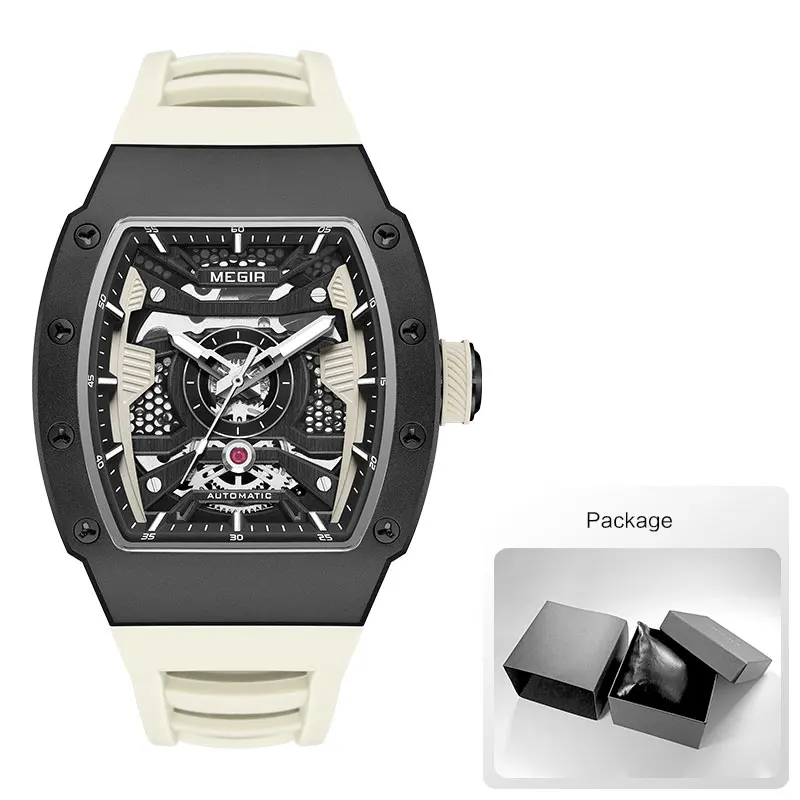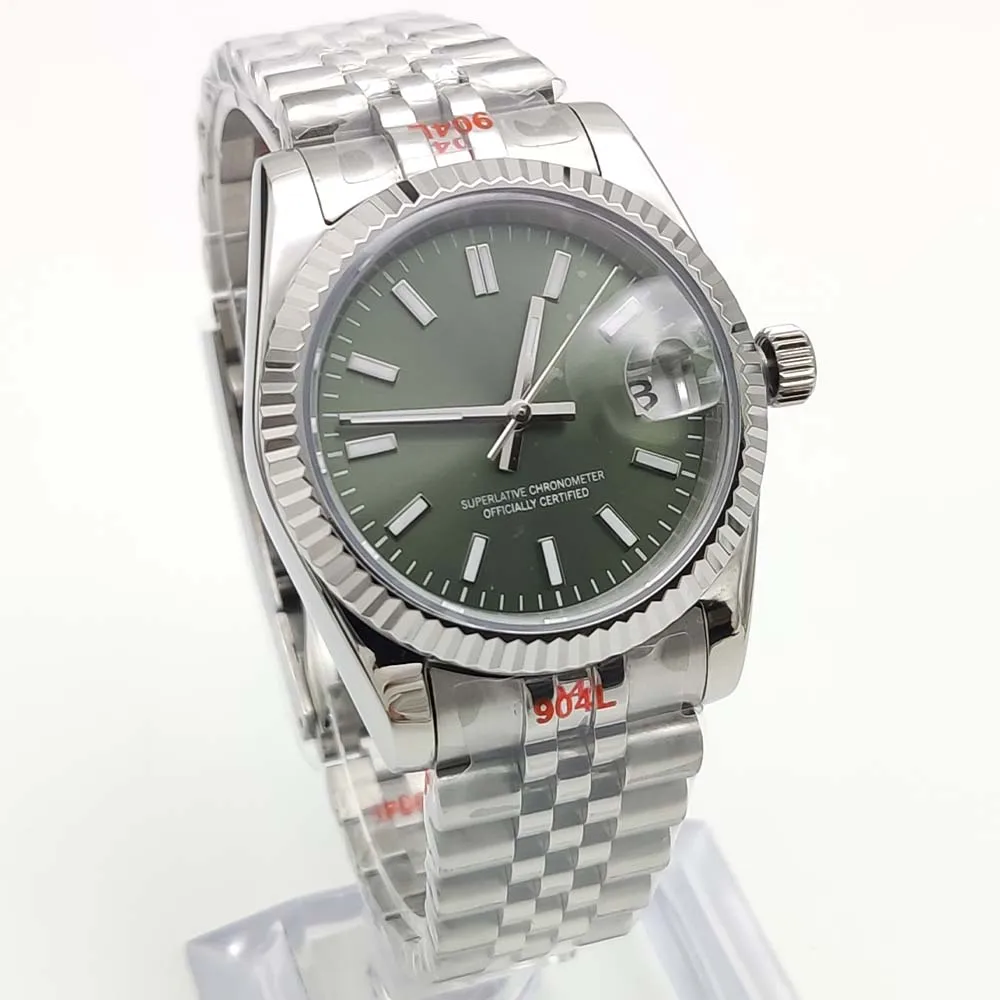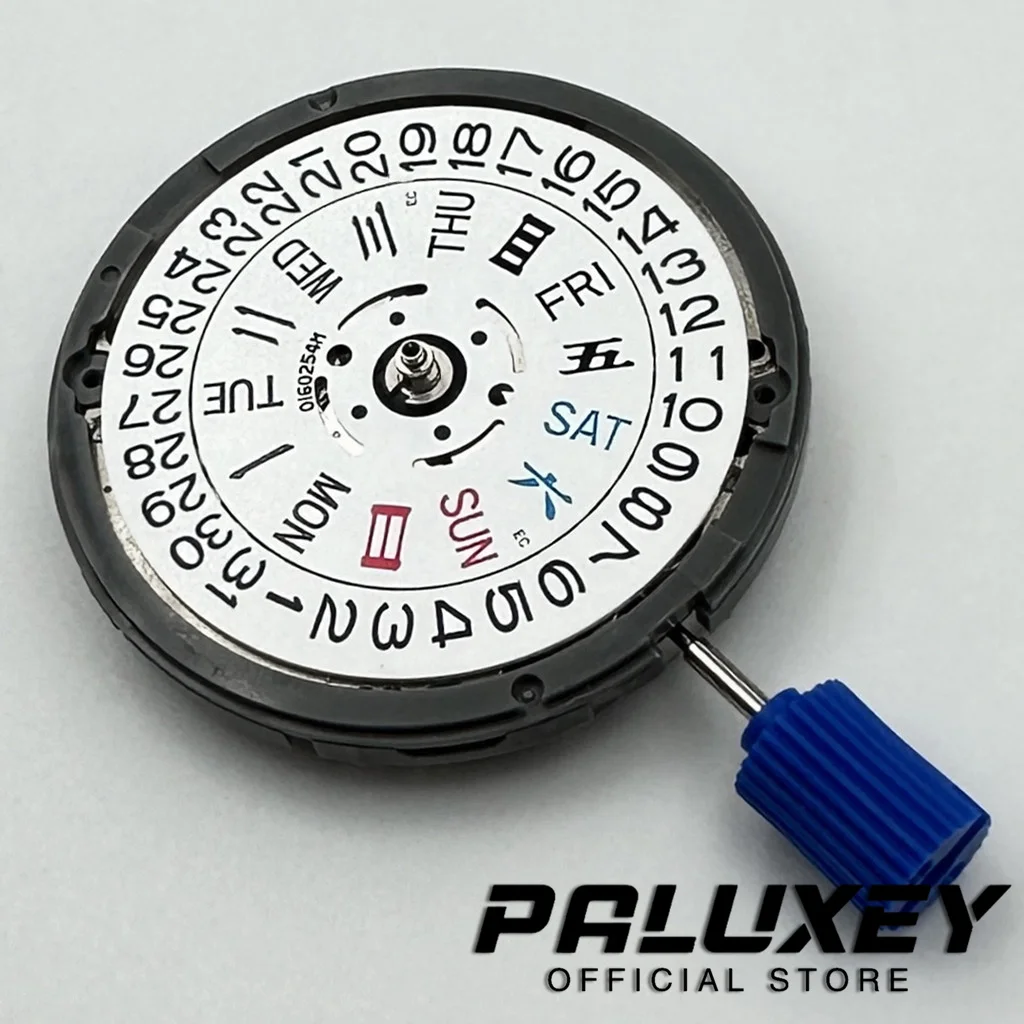Introduction to Day-Date Automatic Watches
Automatic watches represent a pinnacle of traditional watchmaking craftsmanship. These self-winding mechanical timepieces harness the natural motion of your wrist to power their intricate inner workings, eliminating the need for batteries or daily manual winding. When this mechanical ingenuity is paired with day-date complications—sophisticated features displaying both the day of the week and the date—the result is a harmonious blend of convenience and horological artistry.
Day-date watches hold a special place in the world of horology (the art and science of measuring time). They combine practical functionality with mechanical complexity, offering wearers both convenience and a connection to centuries-old watchmaking traditions. These complications require precise engineering to ensure accurate tracking of different-length months and seamless transitions at midnight.
At Sharp Aspect, our philosophy of “Time. Precision. Heritage.” celebrates these mechanical marvels. We appreciate how automatic day-date watches represent the perfect marriage of everyday utility and mechanical sophistication.
In this comprehensive guide, you’ll discover the fascinating inner workings of day-date automatic watches—from the basic principles that power them to the complex mechanisms that advance calendar displays. You’ll learn how these watches differ from other types, how to properly care for them, and why they continue to captivate enthusiasts despite the prevalence of digital alternatives.
The history of dive watch engineering shares similar principles of mechanical excellence that we see in today’s day-date watches. Both represent significant achievements in creating reliable mechanical systems that can withstand daily use while maintaining precision. Our collection of day-date automatic watches showcases these engineering marvels in various styles and designs.
The Fundamental Principles of Automatic Movements
At its core, an automatic watch operates on a beautifully simple principle: converting the kinetic energy from your wrist’s natural movement into stored energy that powers the timekeeping functions. This ingenious system eliminates the need for manual winding when the watch is worn regularly.
Here’s how this energy conversion works:
- Your wrist’s natural movement causes a weighted rotor inside the watch to rotate
- This rotation winds the mainspring (the watch’s power storage device)
- The tension in the mainspring gradually releases to power the watch’s movement
- When worn regularly (typically 8-10 hours daily), the watch maintains power continuously
What separates automatic watches from their manual-wind predecessors is this self-winding capability. While manual watches require daily hand-winding to function, automatic watches harness energy that would otherwise be wasted as your arm moves throughout the day.
The engineering behind this self-winding concept represents a significant advancement over pocket watches, which required deliberate winding each day. Even when not worn, a fully-wound automatic watch will typically continue running for 38-70 hours (known as the “power reserve”), depending on the quality and design of the movement.
Understanding how long automatic watches last helps appreciate why they’re considered long-term investments rather than disposable accessories. The variety of automatic watches available today demonstrates how this fundamental principle has been adapted to countless designs while maintaining the same core functionality.
Key Components of the Automatic Movement
Rotor (Oscillating Weight)
The rotor is the heart of what makes an automatic watch “automatic.” This semicircular weight, often crafted from metals like tungsten, gold, or platinum, pivots freely around its axis. When your wrist moves, the rotor spins, transferring this energy through a series of gears to wind the mainspring. The weight’s material matters—heavier metals like tungsten provide more efficient winding with less movement.
Mainspring and Barrel
The mainspring serves as the watch’s power storage unit. This coiled metal strip sits within the mainspring barrel and stores energy when wound. As it gradually unwinds, it releases energy to power the watch. High-quality movements include a “slipping mechanism” that prevents damage from overwinding. This clever feature allows the rotor to continue turning even when the mainspring is fully wound.
Gear Train
The gear train consists of a series of precisely engineered wheels that transmit energy from the mainspring barrel to the escapement. These gears also reduce the mainspring’s force to an appropriate level while increasing the number of rotations—effectively converting high torque, low-frequency energy into low torque, high-frequency energy needed for precise timekeeping.
Escapement
The escapement regulates the release of energy from the mainspring, ensuring the watch runs at a consistent rate. It consists of an escape wheel and pallet fork that work together to create the distinctive “tick-tock” sound of mechanical watches. Each time the pallet fork locks and releases, it allows the gear train to advance by a fixed amount and sends a pulse of energy to the balance wheel.
Balance Wheel and Hairspring
The balance wheel and attached hairspring form the timekeeping heart of the watch. The balance wheel oscillates back and forth at a consistent rate (typically 28,800 vibrations per hour in modern watches), with each oscillation allowing the escapement to advance by one increment. The hairspring’s properties determine the rate of oscillation, directly affecting the watch’s accuracy.
Jewels
Throughout the movement, synthetic ruby jewels serve as bearings at points of friction. These jewels reduce wear, improve accuracy, and extend the life of the movement. Quality automatic movements typically contain 17-25+ jewels positioned at critical contact points. The jewel count often indicates a movement’s quality and complexity.
The visual beauty of these components is particularly evident in mechanical skeleton watches, where transparent dials allow you to observe these parts working together in perfect harmony.
The Day-Date Mechanism Explained
The day-date mechanism represents an additional layer of complexity built upon the base automatic movement. Positioned beneath the dial, this system consists of multiple interlinked components designed to track and display calendar information.
At its foundation are two key elements:
– The date wheel: A thin disc containing numbers 1 through 31 that rotates once every 31 days
– The day wheel: A separate disc featuring the seven days of the week, rotating once every seven days
These wheels are positioned strategically beneath the dial with openings (windows) cut into the dial to reveal the current day and date. In most designs, the date window appears at the 3 o’clock position, while the day window may appear at 12 o’clock or alongside the date.

The connection between the main timekeeping movement and these calendar discs occurs through a series of intermediary gears and levers. These components translate the rotation of the hour hand into the advancing motion needed for the calendar displays. Typically, the date mechanism is synchronized to advance when the hour hand passes midnight, with the day wheel advancing when the date changes from 31 to 1 (or at month-end).
What makes this system particularly impressive is how it manages date changes for months with fewer than 31 days. While automatic watches can’t account for these variations automatically (except in more advanced perpetual calendar models), they include mechanisms for manual adjustment that allow the wearer to quickly advance both displays when needed.
Premium models often feature day wheels with multiple languages, allowing the wearer to choose their preferred display language. This requires even more complex engineering to maintain proper alignment within the day window.
Understanding how day-date complications work provides greater appreciation for these intricate systems. For those seeking even more sophisticated calendar functions, perpetual calendar automatic watches extend this concept further by automatically adjusting for months of different lengths and even leap years.
Types of Day-Date Change Mechanisms
Not all day-date watches change their displays in the same manner. The engineering approach to this transition varies across different movements, with three main types predominating:
Gradual Change
The simplest mechanism employs a gradual change process. In these watches, the date wheel begins slowly rotating several hours before midnight, with the change completing gradually after midnight. The day wheel follows a similar pattern when transitioning between days. While mechanically simpler, this approach creates a period where the date or day display may appear caught between two positions, making it difficult to read.
Semi-Instantaneous Change
More refined movements utilize a semi-instantaneous change mechanism. This design incorporates spring-loaded jumpers that create tension as the date begins to change. When sufficient force builds, the spring releases, causing the disc to “snap” to its new position more quickly than in gradual systems. While not truly instantaneous, this creates the appearance of a faster change and reduces the time spent between positions.
Instantaneous Change
The most sophisticated (and expensive) approach is the instantaneous change mechanism. These complex systems store energy throughout the day in a dedicated spring, which releases precisely at midnight to advance the display immediately. True instantaneous change mechanisms are engineering marvels, requiring perfect timing and precise energy management to create that satisfying “click” exactly at midnight.
The difference between these mechanisms reflects broader differences in movement quality and price. Higher-end watches typically feature instantaneous or semi-instantaneous changes, while more affordable automatic watches often employ gradual change mechanisms.
Understanding these differences becomes particularly important when following the guidelines in our user guide for setting day-date watches, as different change mechanisms may require slightly different setting approaches.
Setting and Maintaining Your Day-Date Automatic Watch
Proper setting of day-date watches requires understanding both their capabilities and limitations. Most modern automatic watches feature a crown with multiple positions that control different functions:
- Position 0 (Pushed in): Manual winding position
- Position 1 (First click): Quick-set date and/or day position
- Position 2 (Second click): Time setting position
When setting your day-date watch, follow these best practices:
- Always set the time first, then adjust the date and day
- Ensure the watch is showing afternoon hours (past noon) before setting the date
- Avoid adjusting the date or day during the “danger zone” (typically between 9 PM and 3 AM)
- Use the quickset function (if available) for date and day adjustments
- For watches without quickset, carefully advance the time through multiple 24-hour cycles to change the date
The “danger zone” refers to hours when the date change mechanism is engaged and actively preparing to advance the calendar displays. Adjusting these mechanisms during this period can damage the delicate gears and springs involved in the calendar function.
For months with fewer than 31 days, manual adjustment is required at month-end. Simply use the quickset function on the first day of the new month to advance to the correct date.
Proper winding is also essential for automatic watches. While they wind themselves when worn, a stationary automatic watch will eventually deplete its power reserve. To manually wind your watch, turn the crown in its pushed-in position (typically clockwise) about 20-30 times until you feel slight resistance.
The enduring importance of the day-date display has ensured these features remain popular despite their mechanical complexity, as they provide practical information at a glance that enhances the everyday utility of fine timepieces.
Understanding Power Reserve in Automatic Watches
Power reserve refers to how long an automatic watch will continue running when removed from your wrist and left stationary. This critical specification varies widely between movements, typically ranging from 38 hours in standard movements to 70+ hours in premium calibers.
The power reserve is directly related to the mainspring’s capacity and the movement’s energy efficiency. When fully wound, the mainspring stores enough energy to power the watch for its specified reserve period. As you wear the watch, the rotor continuously replenishes this energy, keeping the mainspring wound.
For most automatic watches, wearing the watch for 8-10 hours of normal daily activity will maintain a full power reserve. However, if your lifestyle involves limited wrist movement (such as sitting at a desk all day), your watch may not wind fully through normal wear.

Some premium models feature power reserve indicators—small dials that display the remaining run time, typically shown as a percentage or in hours. This feature helps you monitor when your watch might need additional winding or wearing time.
When an automatic watch’s power reserve depletes completely, the watch stops running. While this doesn’t harm the movement, it means you’ll need to reset the time and date when restarting the watch. For collectors with multiple watches, watch winders provide a solution by mimicking wrist movement to keep unworn watches running.
The intricate mechanisms that manage power can often be viewed in open heart automatic watches, where portions of the dial are cut away to reveal the movement working beneath.
Essential Care and Servicing
Proper care significantly extends the life of your automatic day-date watch. Follow these essential practices:
Regular Cleaning: Wipe the case and bracelet with a soft, slightly damp cloth to remove dirt, sweat, and oils. Pay special attention to areas between links and around the crown.
Proper Storage: When not worn, store your watch in a dry environment away from direct sunlight. Consider a watch box or case to protect from dust and impacts.
Water Resistance Maintenance: Have water resistance tested annually if you regularly expose your watch to water. Gaskets and seals deteriorate over time, reducing water protection.
Avoid Extreme Conditions: Keep your watch away from strong magnetic fields, chemicals, extreme temperatures, and high-impact activities that could damage the movement.
Regular Servicing: Professional servicing every 3-7 years is recommended. This involves disassembling the movement, cleaning components, replacing worn parts, and properly lubricating the mechanism.
Warning signs that your watch needs service include:
– Significant gain or loss of time (more than 15 seconds per day)
– Erratic date or day changes
– Unusual noises from the movement
– Difficulty winding or setting
– Moisture inside the crystal
Professional servicing ensures that the intricate day-date mechanism continues functioning properly. While this maintenance represents an ongoing cost, it’s essential for preserving both functionality and value.
The evolution of dive watch technology has contributed numerous durability innovations that benefit all automatic watches, including improved water resistance, shock protection, and anti-magnetic properties.
Classic Automatic Dress Watches, Day Date Automatic Watches, Perpetual Calendar Automatic Watches
Price range: $540.60 through $574.60 Select options This product has multiple variants. The options may be chosen on the product pageAutomatic Chronograph Watches, Chronograph Pilot Watches
Price range: $233.36 through $237.58 Select options This product has multiple variants. The options may be chosen on the product pageClassic Automatic Dress Watches, GMT Automatic Watches, GMT Pilot Watches
Price range: $1,240.86 through $1,463.33 Select options This product has multiple variants. The options may be chosen on the product pageAutomatic Chronograph Watches, Classic Style Dive Watches
$3,053.06 Select options This product has multiple variants. The options may be chosen on the product pageAutomatic Skeleton Watches, Open Heart Automatic Watches
$98.36 Select options This product has multiple variants. The options may be chosen on the product pageBronze Automatic Watches, Military Inspired Automatic Watches, Professional Spec Dive Watches
Price range: $1,442.21 through $1,442.82 Select options This product has multiple variants. The options may be chosen on the product page
Automatic vs. Other Watch Technologies
Understanding how automatic day-date watches compare to other technologies helps appreciate their unique characteristics:
Automatic vs. Manual Wind
– Power Source: Automatic watches self-wind through wrist movement; manual watches require daily hand-winding
– Convenience: Automatic watches require less daily attention when worn regularly
– Complexity: Automatic movements contain additional components (rotor, reverser gears) that manual movements don’t need
– Case Thickness: Automatic watches are typically thicker to accommodate the rotor mechanism
Automatic vs. Quartz
– Power Source: Automatic watches use mechanical energy; quartz watches use battery power
– Accuracy: Quartz watches are significantly more accurate (±15 seconds/month vs. ±5-20 seconds/day for automatics)
– Maintenance: Quartz watches require battery changes every 1-3 years; automatic watches need mechanical servicing every 3-7 years
– Second Hand Movement: Automatic watches have a sweeping seconds hand; quartz typically has a ticking motion
– Craftsmanship: Automatic watches represent traditional horological craftsmanship with hundreds of hand-assembled parts
Day-Date vs. Simple Date
– Complexity: Day-date movements contain approximately 25-30% more parts than simple date movements
– Functionality: Day-date provides additional information at a glance
– Setting: Day-date requires more attention during setting, especially when adjusting after periods of non-use
The differences between day-date and date-only watches extend beyond mere functionality to considerations of movement complexity and traditional craftsmanship appreciation.
Benefits and Limitations of Day-Date Automatic Watches
Understanding both the advantages and disadvantages of day-date automatic watches helps set proper expectations for ownership.
Benefits:
– Heritage and Craftsmanship: Automatic watches represent centuries of horological tradition and mechanical ingenuity
– No Battery Required: Never worry about battery changes or finding yourself with a dead watch
– Generational Longevity: With proper care, automatic watches can be passed down for generations
– Mechanical Artistry: The intricate engineering represents true mechanical art that can be appreciated visually and functionally
– Daily Convenience: Day-date displays provide practical information at a glance
– Investment Potential: Quality automatic watches often retain value better than quartz alternatives
– Connection: Many owners feel a deeper connection to a mechanical timepiece that requires interaction
Limitations:
– Accuracy Considerations: Even excellent automatic movements (±2-5 seconds/day) can’t match quartz accuracy (±15 seconds/month)
– Regular Adjustment Needed: Date displays require manual adjustment for months with fewer than 31 days
– Maintenance Requirements: Professional servicing every 3-7 years represents an ongoing cost
– Sensitivity to Wear Patterns: Performance depends on regular wearing or manual winding
– Higher Initial Investment: Quality automatic day-date watches typically cost more than quartz alternatives
– Complexity: The intricate mechanisms can be damaged if not properly set or maintained
– Size Constraints: The additional day-date mechanism often results in slightly thicker watches
The practical functionality and traditional craftsmanship of automatic watches with day-date features continue to appeal to those who appreciate both the engineering and aesthetics of fine timepieces.
Frequently Asked Questions About Day-Date Automatic Watches
Can an automatic watch be overwound?
Modern automatic watches include a slipping mechanism in the mainspring that prevents damage from overwinding. This allows the rotor to continue turning even when the mainspring is fully wound, making it virtually impossible to overwind through normal use.
How often should an automatic watch be worn to keep it running?
For most automatic watches, wearing it for 8-10 hours of normal daily activity will maintain its power reserve. Watches with longer power reserves (60+ hours) might maintain operation with less frequent wear.
What happens if my day-date automatic watch stops completely?
If your watch stops, simply reset the time and date, wind it manually about 20-30 times, and start wearing it again. There’s no harm to the movement when it stops due to power reserve depletion.
Why is manual date setting dangerous during certain hours?
Between approximately 9 PM and 3 AM, the date change mechanism is engaged and preparing to advance. Manually changing the date during this period can cause gear teeth to misalign or break components in the calendar mechanism.

How accurate should I expect my automatic day-date watch to be?
Quality automatic watches typically maintain accuracy within ±5-15 seconds per day. Premium movements may achieve ±2-5 seconds daily variance. This is a function of mechanical limitations and significantly less accurate than quartz watches.
Is it normal for automatic watches to make noise when the rotor spins?
Yes, a gentle swishing sound when the watch moves is normal—this is the rotor spinning to wind the mainspring. However, loud clicking or grinding noises may indicate a problem requiring service.
What’s the difference between quickset and non-quickset date functions?
Quickset mechanisms allow date or day adjustment directly through crown positions without needing to cycle the hour hand through full 24-hour periods. Non-quickset watches require advancing the time through multiple midnight transitions to change the date.
Why do some day-date watches cost significantly more than others?
Price differences reflect movement quality (finishing, accuracy, power reserve), materials used (case, crystal, strap), brand heritage, and complications beyond basic day-date functions. Higher-end watches often feature instantaneous date changes, longer power reserves, and more precise adjustment.
The experience of owning manual wind watches differs significantly from automatic watches, primarily in the daily interaction required to keep them running.
Appreciating the Artistry of Mechanical Day-Date Complications
There’s something undeniably special about watching a mechanical day-date display click precisely at midnight, advancing to the next day without any electronic assistance. This daily ritual represents the culmination of centuries of watchmaking innovation and the harmonious interaction of dozens of precisely engineered components.
The day-date complication exemplifies the watch industry’s ability to blend practical utility with mechanical artistry. These displays enhance the wearer’s experience by providing useful information while showcasing the watchmaker’s skill in creating reliable, compact calendar systems that can function accurately for decades with proper care.
In today’s digital world, where electronic devices display time and date with perfect accuracy, the continued appreciation for mechanical day-date watches speaks to something deeper than mere timekeeping. It represents an appreciation for craftsmanship, engineering excellence, and the remarkable achievement of creating complex mechanical systems that work reliably on such a small scale.
At Sharp Aspect, we celebrate this harmonious relationship between form and function. The mechanical ingenuity of day-date complications embodies our commitment to horological excellence—timepieces that not only tell time but tell a story of human creativity, precision engineering, and enduring craftsmanship.







